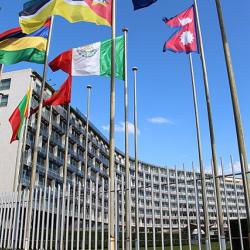Convention Concerning the Protection of the World Cultural and Natural Heritage

The cultural and natural heritage represents the identity of all peoples of the world and constitutes an irreplaceable point of reference. Therefore, its legacy must be safeguarded and passed on from generation to generation. With the Convention on the Protection of Cultural and Natural Heritage [1] (World Heritage Convention or World Heritage Convention), adopted in 1972 [2], UNESCO defined the concept of World Heritage Site (or World Heritage) and sanctioned the birth a World Heritage Sites List (WHL).
The Sites and cultural, natural, or mixed assets [3] included in the World Heritage List belong to all peoples of the world, regardless of the territory on which they are located. The concept of “Outstanding Universal Value” (OUV) recognizes the possession of certain distinctive characteristics of World Heritage Sites and assets and qualifies them as among the most important in the world [4]. The main body in charge of the implementation of the Convention, the World Heritage Committee, has developed precise criteria for inclusion in the World Heritage List, which are outlined in the "Operational guidelines for the implementation of the World Heritage Convention" [5] (hereinafter also referred to as Guidelines or OG [6]).
The 1972 Convention is a legally binding instrument for Signatory States. While fully respecting the sovereignty of the States where the properties and Sites included in the World Heritage List are located, the Convention establishes the duties of the Signatory States which, through ratification, recognize the existence of a collective interest on the part of the international community and, hence, become part of an international cooperation mechanism for the protection and conservation of such heritage [7]. The Convention, therefore, confers on the States the role of protecting and enhancing their cultural and natural heritage, through the implementation of special measures and program tools for territorial planning, the enabling of the development of qualified personnel, specialized services for the Sites, technical-scientific research programs, and through the conservation and provision of other actions that result in the heritage playing an important function in their communities.
The 5 Strategic Objectives of the Convention
The 5 Strategic Objectives of the Convention, known as the "5Cs", which guided the World Heritage Center in drafting the Operational Guidelines since the 2002 Budapest Declaration, constitute the areas of intervention of the Plan. The three phases of analysis, design and planning are listed, according to these Strategic Objectives, below:
- Credibility: Strengthen the credibility of the World Heritage List, as a representative and geographically balanced testimony of cultural and environmental assets of Outstanding Universal Value.
- Conservation: Ensuring effective protection and conservation of the World Heritage over time
- Capacity building: Promote the development of effective measures for the understanding and implementation of the World Heritage Convention and related enabling tools by carrying out training activities for different categories of stakeholders.
- Communication: Raise public awareness, activate methods for their involvement and support for the protection of the World Heritage through the effective communication of the value it holds.
- Community: Strengthen the role of communities in the implementation of the World Heritage Convention.
-
- https://www.unesco.beniculturali.it/en/la-convenzione-sul-patrimonio-mondiale/.
- During the seventeenth General Conference of the United Nations Educational, Scientific and Cultural Organization, held in Paris from 17 October to 21 November 1972.
- Mixed heritage (cultural and natural) corresponds, in part or in whole, to both definitions of cultural and natural heritage
- “Outstanding Universal Value means cultural and/or natural significance which is so exceptional as to transcend national boundaries and to be of common importance for present and future generations of all humanity. As such, the permanent protection of this heritage is of the highest importance to the international community as a whole. The Committee defines the criteria for the inscription of properties on the World Heritage List.” Source: Operational Guidelines for the Implementation of the World Heritage Convention, Paragraph 49.
- The Guidelines contain all the precise criteria for the inclusion of Sites and assets in the World Heritage List and for international assistance within the scope of the provisions of the World Heritage Fund. The Guidelines were first drafted in 1977 (five years after the implementation of the Convention) by the World Heritage Committee, the main body in charge of the implementation of the Convention, which periodically updates these Guidelines in order to update concepts, knowledge and experience. All editions are available at the following link: http://whc.unesco.org/en/guidelines/. The Guidelines contain all the precise criteria for the inclusion of sites and assets in the World Heritage List and for international assistance within the scope of the provisions of the World Heritage Fund.
- Acronym of the English definition of the Operational Guidelines for the Implementation of the World Heritage Convention.
- As in Art. 4 of the Convention, the participating States undertake the obligation to ensure the identification, protection, conservation, enhancement and transmission, to future generations, of the cultural and natural heritage located in their territory..
